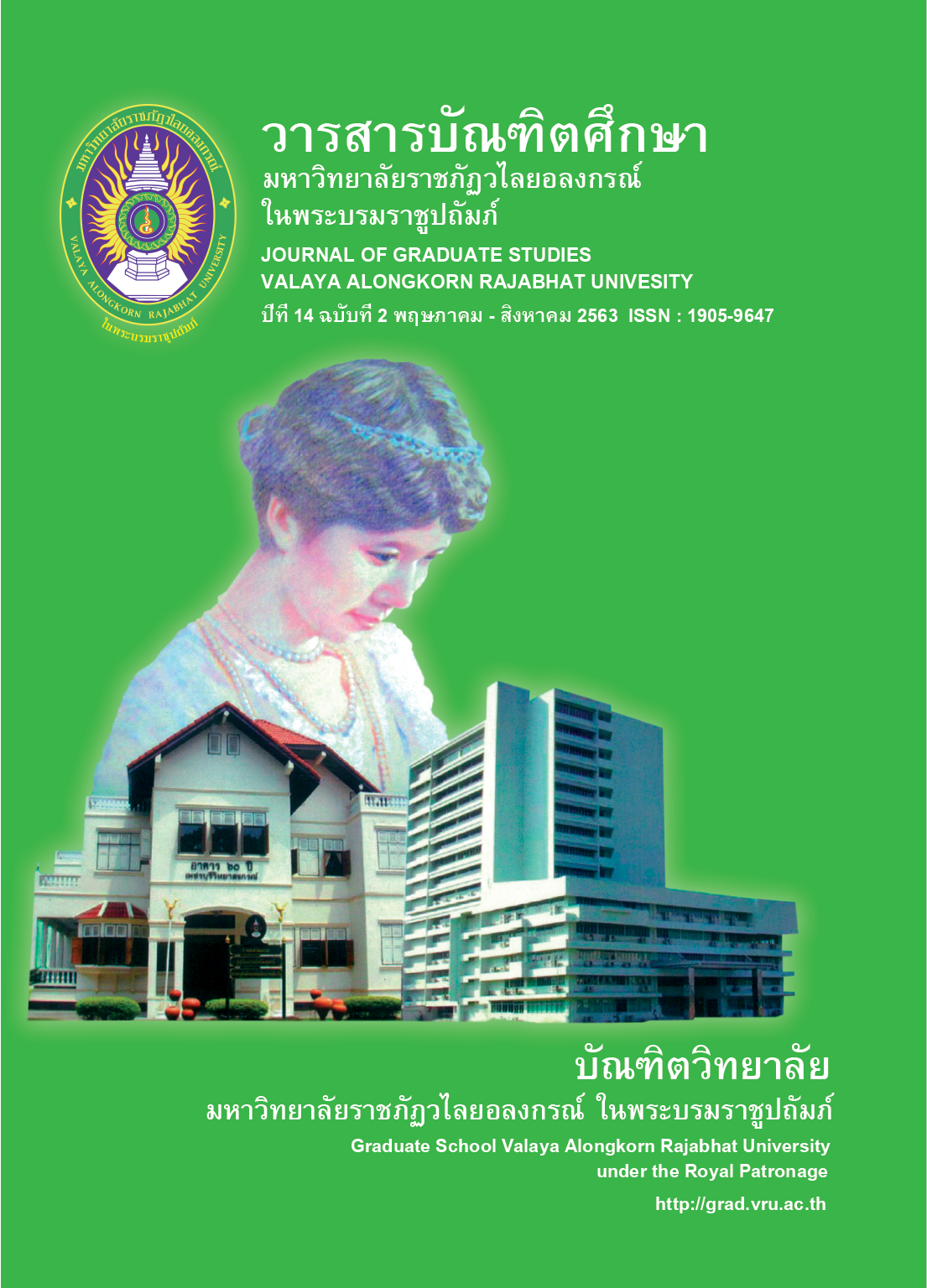A CAUSAL STRUCTURAL MODEL OF FACTORS AFFECTINGLEARNING ORGANIZATION UNDER PHRA NAKHON SI AYUTTHAYA PRIMARY EDUCATIONAL SERVICE AREA OFFICE
Main Article Content
Abstract
The purposes of this research were 1) to study levels of learning organization perceived by the administration under the Phra Nakhon Sri Ayutthaya Primary Educational Service Area Office 2) to study the casual structural model of factors affecting learning organization under the Phra Nakhon Sri Ayutthaya Primary Educational Service Area Office. The sample were 324 administrators selected by stratified random sampling. The research instruments was questionnaire measuring the learning organization and the factors affecting learning organization which reliability value was 0.965. The data was analyzed by using descriptive statistics, Pearson correlation analysis with statistical software package and analysis of causal linear structure.
The finding revealed that:
1) Learning Organization in total was high level. The aspect with the highest average score were organizational change and empowerment and personal’s capacity building, follow by the dynamic of learning, the learning organization, and the increase the ability to use technology with the high average score.
2) Learning organization under the Phra Nakhon Sri Ayutthaya Primary Educational Service Area Office was the most positive Influenced by the personal development within the organization variable which path coefficients was 0.25 followed by the management strategy variables which path coefficients was 0.19. Organizational commitment variables which path coefficients was 0.18. Motivation within the organization variable which path coefficients was 0.16.Participation in administration variables which path coefficients was 0.15 and internal communication variable which path coefficients was 0.14. In addition, the casual variables can explain the variance of the variables of learning organization under the Phra Nakhon Sri Ayutthaya Primary Educational Service Area Office at under the Phra Nakhon Sri Ayutthaya Primary Educational Service Area Office.85 percent. The causal structural model of factors affecting was appropriate and consistent with empirical data in the good level (= 0.00, df = 0, p-value = 1.00, RMSEA = 0.000) accordance with the hypothesis.
Article Details
บทความทุกเรื่องได้รับการตรวจความถูกต้องทางวิชาการโดยผู้ทรงคุณวุฒิ ทรรศนะและข้อคิดเห็นในบทความวารสารบัณฑิตศึกษา มหาวิทยาลัยราชภัฏวไลยอลงกรณ์ ในพระบรมราชูปถัมภ์ มิใช่เป็นทรรศนะและความคิดของผู้จัดทำจึงมิใช่ความรับผิดชอบของบัณฑิตวิทยาลัย มหาวิทยาลัยราชภัฏวไลยอลงกรณ์ ในพระบรมราชูปถัมภ์ กองบรรณาธิการไม่สงวนสิทธิ์การคัดลอก แต่ให้อ้างอิงแหล่งที่มา
References
Best, J. W. (1981). Research in Education. Englewood Cliffs: Prentice Hall.
Butsaba, W. (2010). kānsưksā patčhai thī song phon tō̜ kān pen ʻongkō̜n hǣng kānrīanrū khō̜ng sathān sưksā sangkat samnakngān khana kammakān kānsưksā naphư̄n thān [The study of factors affecting the learning organization of educational institutions under the office of the Commissionbasic education]. Doctoral dissertation. Siam University.
Chaikumhan, S. (2007). patčhai thī mī ʻitthiphon tō̜ kān pen ʻongkō̜n hǣng kān rīanrū khō̜ng sathān sưksākhan phư̄nthān [Factors influencing learning organization of the basic eduction schools]. Doctoral dissertation. Silapakorn University.
Hair, J. F. et al. (1998). Multivariate Data Analysis. 5th ed. Upper Saddle River, New Jersey: Prentice Hall.
Hoy, W. K. and Miskel, C. G. (2001). Educational Administration: Theory, Research, and Pratice. New York: Mc Graw-Hill.
Lunenburg, F. & Ornstein, A. (2004). Educational Administration: Concepts and Practices. 4thed. Belmont: Wadsworth/Thompson Learning.
Marquardt, M. J. (1996). Building the learning Organization: a Systems Approach to Quantum Improvement and Global Success. New York: McGraw-Hill.
Ministry of Education. (1999). phrarātchabanyat kānsưksā hǣng chāt. Phō̜.Sō̜. sō̜ngphanhārō̜isīsipsō̜ng læ thī kǣkhai phœ̄mtœ̄m (chabap thī sō̜ng) Phō̜.Sō̜.2002 [National Education Act. 1999 and amended (Issue 2) 2002]. Bangkok: KruFederation Printing Factory, Ladprao.
Phra Nakhon Si Ayutthaya Provincial Education Office. (2017). phǣn patibat rātchakānpračham pīngoppramān Phō̜.Sō̜. 2017 [Government action plan for the fiscal year 2017]. Phra Nakhon Si Ayuthaya; Phra Nakhon Si Ayutthaya Provincial Education Office.
Runcharoen, T. (2005). sū khwāmpen phūbō̜rihān sathān sưksā mư̄ʻāchīp [To become a professional school administrator]. Bangkok: millet.
Schumacher, R. E. & Lomax, R. G. (1996). A beginner’s guide to Structural Equation Modeling. New Jersey: Lawrence Erlbaum Associates, Publishers.
Srisa-ard, B. (2002). withīkān sāng sathiti sārap kānwičhai [How to create statistics for research]. Bangkok: Suweeriyasan.
Supkrasae, M. (2009). kānphatthanā rūpbǣp ʻongkān hǣng kān rīanrū khō̜ng samnakngān khēt phư̄nthī kānsưksā [Development of a learning organization model of the Office of Educational Service Area]. Doctoral dissertation. Siam University.
Yamo, R. (2013). patčhai kānbō̜rihān thī song phon tō̜ saphāp kān pen ʻongkān hǣng kān rīanrū khō̜ng sathān sưksā nai sām čhangwat chāidǣn phāktai [Administrative factors affecting learning organization of schools in three southern border provinces]. Master’s thesis. Prince of Songkla University.


